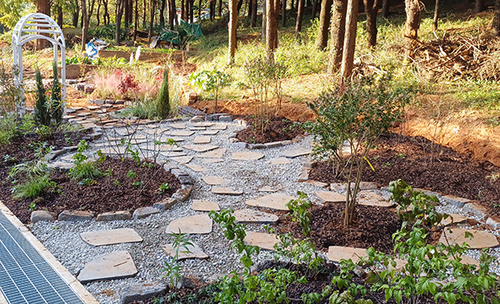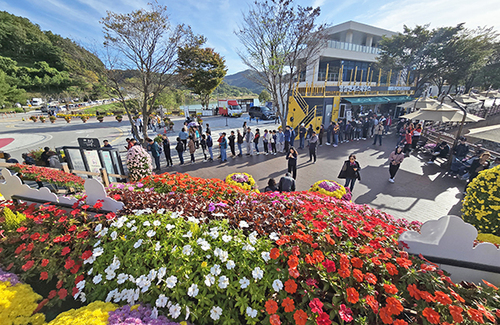| в–І м „л¶Ғ кі м°Ҫкө° м•„мӮ°л©ҙ 'лі‘л°”мң„' мқјмӣҗмқҙ мһҗм—°кІҪкҙҖ л°Ҹ м—ӯмӮ¬гҶҚл¬ёнҷ”м Ғ к°Җм№ҳлҘј мқём •л°ӣм•„ көӯк°Җм§Җм •л¬ёнҷ”мһ¬ лӘ…мҠ№(еҗҚеӢқ)мңјлЎң м§Җм • мҳҲкі лҗҗлӢӨ. / мӮ¬м§„м ңкіө = кі м°Ҫкө°мІӯ © к№Җк°ҖмҳҒ кё°мһҗ |
|
м „л¶Ғ кі м°Ҫкө° м•„мӮ°л©ҙ 'лі‘л°”мң„' мқјмӣҗмқҙ мһҗм—°кІҪкҙҖ л°Ҹ м—ӯмӮ¬гҶҚл¬ёнҷ”м Ғ к°Җм№ҳлҘј мқём •л°ӣм•„ көӯк°Җм§Җм •л¬ёнҷ”мһ¬ лӘ…мҠ№(еҗҚеӢқ)мңјлЎң м§Җм • мҳҲкі лҗҗлӢӨ.
лӘ…мҠ№мқҖ лӢӨлҘё л¬ёнҷ”мһ¬м—җ 비н•ҙ мҡ°лҰ¬лӮҳлқјм—җм„ңлҸ„ 120кё° м •лҸ„л§Ң м§Җм •лҗ м •лҸ„лЎң нқ¬мҶҢм„ұмқҳ к°Җм№ҳмҷҖ кҙҖкҙ‘нҡЁкіјк°Җ л§Өмҡ° нҒ° көӯк°Җм§Җм •л¬ёнҷ”мһ¬лӢӨ.
нҠ№нһҲ 'кі м°Ҫ лі‘л°”мң„'мІҳлҹј мһҗм—°мң мӮ°мқё л°”мң„к°Җ л¬ёнҷ”мһ¬лЎң м§Җм •лҗң мӮ¬лЎҖлҠ” 10м—¬ кё°м—җ л¶Ҳкіјн•ҳлӢӨ.
кі м°Ҫкө°мқҖ "л¬ёнҷ”мһ¬мң„мӣҗнҡҢк°Җ 30мқјк°„ м§Җм •мҳҲкі л°Ҹ к°Ғкі„ мқҳкІ¬мқ„ мҲҳл ҙн•ҳлҠ” мӢ¬мқҳ м Ҳм°ЁлҘј кұ°міҗ көӯк°Җм§Җм •л¬ёнҷ”мһ¬ лӘ…мҠ№(еҗҚеӢқ)мңјлЎң мөңмў… м§Җм •н•ҙ л¬ёнҷ”мһ¬ліҙнҳёлІ•м—җ л”°лқј мІҙкі„м Ғмқё ліҙмЎҙкіј нҷңмҡ©л°©м•Ҳмқҙ л§Ҳл ЁлҗңлӢӨ"кі 1мқј л°қнҳ”лӢӨ.
'лі‘л°”мң„'лҠ” лі‘мқ„ кұ°кҫёлЎң м„ёмӣҢ лҶ“мқҖ лӘЁм–‘ к°ҷкё°лҸ„ н•ҳкі л©ҖлҰ¬м„ң ліҙл©ҙ мӮ¬лһҢ м–јкөҙ к°ҷкё°лҸ„ н•ң л¬ҳн•ң лӘЁм–‘мқ„ н•ҳкі мһҲмңјл©° лҶ’мқҙ 35m м •лҸ„мқҳ нҒ¬кё°лЎң мң—л¶Җ분мқҙ нҒ¬кі м•„лһҳлЎң лӮҙл Өмҳ¬мҲҳлЎқ мһҳлЎқн•ҳлӢӨ.
м§Җм§Ҳм•”м„қ н’Қнҷ”мһ‘мҡ©мқҳ лҢҖн‘ңм Ғ нҠ№м§•мқё 'нғҖнҸ¬лӢҲ(tafoni = л°”мң„мЎ°к°Ғмқҙ л–Ём–ҙм ё лӮҳк°„ нҢЁмқё н’Қнҷ”нҳҲгҶҚйўЁеҢ–з©ҙ)'мҷҖ 'мқёмІңк°• н•ҳкө¬мҠөм§Җ'мҷҖ м—°кІ°лҗҳлҠ” 주진мІңмқҳ мғқнғңлҘј кҙҖм°°н• мҲҳ мһҲлӢӨ.
л°”мң„лҠ” мҶҢл°ҳл°”мң„гҶҚл‘җлқҪм•”(м „мўҢл°”мң„) л“ұ мЈјліҖкіјлҸ„ мһҳ м–ҙмҡёл Ө кІҪкҙҖм Ғ к°Җм№ҳк°Җ нҒ¬кі л°”мң„ мЈјліҖ л‘җм•”мҙҲлӢ№м—җм„ң к°•н•ҷм—җ кҙҖл Ёлҗң лӢӨм–‘н•ң л¬ён—Ңкіј н•Ёк»ҳ мӢңгҶҚкёҖгҶҚк·ёлҰјмңјлЎңлҸ„ мҳӨлһң кё°к°„ кі м°Ҫнҳ„гҶҚнқҘлҚ•нҳ„гҶҚл¬ҙмһҘнҳ„ л“ұм—җм„ң м§Җм—ӯмқҳ лӘ…мҠ№мңјлЎң м—ӯмӮ¬гҶҚл¬ёнҷ”гҶҚкІҪкҙҖм Ғ к°Җм№ҳк°Җ лӣ°м–ҙлӮң кіімқҙлӢӨ.
м§Җм§Ҳн•ҷм ҒмңјлЎң лі‘л°”мң„ мқјмӣҗмқҖ 1м–ө5,000л§Ңл…„ м „л¶Җн„° нҳ•м„ұлҗң кё°м•”кҙҙм„қмңјлЎң м№ЁмӢқмңјлЎң мғқкІЁлӮң мҲҳл§ҺмқҖ лӢЁм• (cliff = мҲҳм§ҒмңјлЎң к№Қм•„м§ҖлҘё м ҲлІҪ)гҶҚмҠӨнғқ(stack = мёөмёөмқҙ мҢ“мқё нҮҙм Ғм•”)мқҙ мһҲкі мң л¬ём•”м§Ҳ мқ‘нҡҢм•”мқҳ л…ёл‘җлҘј кҙҖм°°н• мҲҳ мһҲмңјл©° нғҖнҸ¬лӢҲ н•ҷмҠөмһҘмҶҢлЎң м Ғн•©н•ҳлӢӨ.
лҳҗ, лі‘л°”мң„м—җ м°©мғқн•ҙ м„ңмӢқн•ҳлҠ” лҚ©көҙлҘҳ(л°ұнҷ”л“ұгҶҚлӢҙмҹҒмқҙ)мқҳ мӢқмғқн•ҷм Ғ к°Җм№ҳмҷҖ кі„м Ҳм—җ л”°лқј мғүмқ„ лӢ¬лҰ¬н•ҳлҠ” л“ұмқҳ кІҪкҙҖм Ғ к°Җм№ҳк°Җ нӣҢлҘӯн•ҙ лӘ…мҠ№м Ғ м§Җм • мЎ°кұҙмқё кІҪкҙҖ мғқнғңм ҒгҶҚл¬ёнҷ”м ҒгҶҚм—ӯмӮ¬м Ғ мқҳлҜёк°Җ л№јм–ҙлӮҳлӢӨ.
лі‘л°”мң„лҠ” 'м—¬м§ҖлҸ„м„ң(нқҘлҚ• 1757)'мҷҖ 'н•ҙлҸҷм§ҖлҸ„(1750л…„лҢҖ мҙҲ)гҶҚнҳёлӮЁмқҚм§ҖгҶҚм§Җл°©м§ҖлҸ„гҶҚкі м°Ҫнҳ„кіј нқҘлҚ•нҳ„(1872)' л“ұ м—¬лҹ¬ кё°лЎқм—җ нҳёлҰ¬лі‘ л°”мң„лқјлҠ” лң»мқҳ 'нҳём•”(еЈәе·–)'мңјлЎң н‘ңкё°лҗҗкі лі‘ лӘЁм–‘мңјлЎң к·ёл Өм ё мһҲлҠ” л¬ён—ҢмһҗлЈҢ л“ұлҸ„ нҷ•мқёлҸј м—ӯмӮ¬м„ұлҸ„ к°–м·„лӢӨ.
кҙҖл Ёлҗң м „м„ӨмқҖ 'м„ лҸҷл§Ҳмқ„ л’Ө м„ мқёлҙү л°ҳм•” л’Ө мһ”칫집м—җм„ң лӘ№мӢң м·Ён•ң мӢ м„ мқҙ м“°лҹ¬м§Җл©ҙм„ң мҶҢл°ҳ(е°ҸзӣӨ = мһ‘мқҖ л°ҘмғҒ)мқ„ кұ·м–ҙм°Ёмһҗ мҶҢл°ҳ мң„ мҲ лі‘мқҙ көҙлҹ¬ л–Ём–ҙм ё мқёмІңк°•к°Җм—җ кұ°кҫёлЎң кҪӮнһҢ кІғмқҙ лі‘л°”мң„к°Җ лҗҳм—ҲлӢӨ'лҠ” мқҙм•јкё°к°Җ м „н•ҙм ё лӮҙл ӨмҳӨкі мһҲлӢӨ.
мң кё°мғҒ кі м°Ҫкө°мҲҳлҠ” "кі м°Ҫк°ҜлІҢмқҳ мң л„ӨмҠӨмҪ” м„ёкі„мһҗм—°мң мӮ° л“ұмһ¬мҷҖ н•Ёк»ҳ лҳҗ н•ҳлӮҳмқҳ көӯк°Җм§Җм • лӘ…мҠ№ м§Җм •мңјлЎң 'мІӯм •кі м°Ҫ'л°Ҹ 'мғқнғң м№ҳмң мқҳ м—ӯмӮ¬гҶҚл¬ёнҷ”гҶҚкҙҖкҙ‘лҸ„мӢң'мқҙлҜём§ҖлҘј лҚ”мҡұ л¶Җк°ҒмӢңнӮ¬ мҲҳ мһҲкІҢ лҗҗлӢӨ"кі л°қнҳ”лӢӨ.
к·ёлҹ¬л©ҙм„ң "кё°мЎҙмқҳ кҙҖкҙ‘ л°Ҹ л¬ёнҷ”м •мұ…кіј м—°кі„н•ҙ мӢңл„Ҳм§Җ нҡЁкіјлҘј л°ңнңҳн• мҲҳ мһҲлҸ„лЎқ н–үм •л Ҙмқ„ лӘЁмңјкІ лӢӨ"кі лҚ§л¶ҷмҳҖлӢӨ.
вҳһ м•„лһҳлҠ” мң„ кё°мӮ¬лҘј кө¬кёҖ лІҲм—ӯмқҙ лІҲм—ӯн•ң мҳҒл¬ёмқҳ 'м „л¬ё'мқҙлӢӨ.
гҖҗBelow is the 'full text' of an English article translated from the above article with Google Translate.гҖ‘
Gochang Byeongbawi Rock designated as 'National Cultural Heritage Site of Scenic Beauty'
Cultural Heritage AdministrationвҖҰ High evaluation of beautiful scenery, historical and cultural values
Reporter Kim Ga-young
The area of 'Byeongbawi' in Asan-myeon, Gochang-gun, Jeollabuk-do has been recognized for its natural scenery and historical and cultural value, and has been designated as a nationally designated cultural heritage site of scenic beauty.
Scenic Spots are nationally designated cultural properties with a high value of rarity and tourism effect, to the extent that only about 120 sites are designated in Korea compared to other cultural properties.
In particular, there are only about 10 cases of natural heritage rocks designated as cultural assets, such as 'Gochang Byeongbawi Rock'.
Gochang-gun announced on the 1st that "The Cultural Heritage Committee will finally designate it as a nationally-designated cultural heritage site after a 30-day notice of designation and a deliberation process that collects opinions from various fields, and a systematic preservation and utilization plan will be prepared in accordance with the Cultural Heritage Protection Act."
'Byungbawi' looks like an upside-down bottle, and when viewed from a distance, it has a strange shape that resembles a human face.
You can observe 'tafoni', which is a typical characteristic of geological rock weathering, and the ecology of Jujincheon, which is connected to 'Incheon River Estuary Wetland'.
The rocks have great scenic value as they blend well with the surrounding areas such as Sobanbawi Rock and Durakam Rock (Jeonjwabawi Rock). It is a place of outstanding historical, cultural, and scenic value as a local scenic spot.
Geologically, the area of Byeongbawi Rock is a strange rock formation formed 150 million years ago, and there are numerous cliffs (cliff = vertical cliffs) and stacks (stack = sedimentary rocks stacked in layers) formed by erosion, and outcrops of rhyolite tuff can be observed. It is also suitable as a place for tarpony learning.
In addition, the ecological, cultural, and historical significance of the landscape, which is a condition for designation as a scenic spot, is outstanding due to the vegetative value of vines (flowers and ivy) that are epiphytic and inhabiting the rocks and the landscape value, such as changing colors according to the seasons.
Byeongbawi is named вҖҳHoam (еЈәе·–)вҖҷ, meaning Goribyeong Rock, in various records such as вҖҳYeojidoseo (Heungdeok 1757)вҖҷ and вҖҳHaedongjido (early 1750s), Honam-eupji, local maps, Gochang-hyeon and Heungdeok-hyeon (1872)вҖҷ. ' and documented material drawn in the shape of a bottle have also been confirmed, giving it a sense of history.
A related legend is that, "At the feast house behind Seoninbong porphyry behind Seondong Village, a very drunk god fell and kicked a soban (е°ҸзӣӨ = small table). it's coming down
On the other hand, Gochang-gun Mayor Yu-sang Yu-sang said, "With the registration of Gochang Tidal Flat as a UNESCO World Natural Heritage Site, it is possible to further emphasize the image of 'Clean Gochang' and 'City of history, culture and tourism of ecological healing' by designating another nationally designated scenic spot." said.
He added, "We will gather administrative power so that we can create synergy effects in connection with existing tourism and cultural policies."




 м»Өл®ӨлӢҲнӢ°
м»Өл®ӨлӢҲнӢ°  н”јн”Ң
н”јн”Ң  лҸ…мһҗнҲ¬кі
лҸ…мһҗнҲ¬кі
















 л§Һмқҙ ліё лүҙмҠӨ
л§Һмқҙ ліё лүҙмҠӨ











